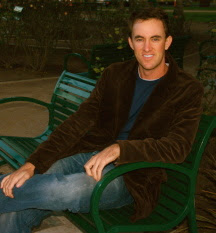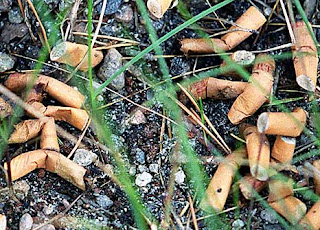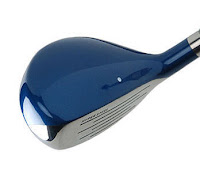Last week I posted Part One of the Geoff Shackelford interview in which we discussed his golf game and some thoughts on golf course architecture.
 As promised, here is the rest of the interview which covers his writing and some personal topics. For some background, you can check out Geoff’s bio on his website.
As promised, here is the rest of the interview which covers his writing and some personal topics. For some background, you can check out Geoff’s bio on his website.
You’ll notice a couple of times he references the Masters as though it hasn’t happened yet. He actually submitted these responses back to me while I was on a break from blogging, right before the Masters took place.
Once again, Scott Tesar provided a few questions, which are denoted with his initials (ST) in place of my own (KW).
Enjoy!
Geoff Shackelford interview – Part Two
Writing KW: When did your interest in writing begin/how did it develop?GS: I edited my high school paper and have always loved reading the newspaper. Though I rarely opened a book until the age of 20.
KW: Who was the first person who acknowledged your talent and encouraged you?
GS: My parents.
KW: Does the insecurity even end?
GS: Of course not. I can’t stand to read stuff I’ve done that’s more than 2 weeks old.
KW: Clearly you have a creative mind. Have you ever pursued any other ways to express it in addition to architecture and writing?
GS: Well besides my work as a male stripper and my “Def poetry” rants on postmodernism as it relates to the life and work of Leroy Neiman? Oh, sorry. Well, I wrote a couple of movie treatments and a novel, both with some golf in them. Not sure if those count.
KW: Do you write about other subjects than golf and golf architecture?
GS: Nope. I should, but golf has thankfully been keeping me busy and paying the rent.
KW: When and where were you first published? How did it happen?
GS: Riviera Country Club hired me to do a club history in time for the 1995 PGA. That was privately published. After that Masters of the Links was the first actual book bought by a publisher. As for magazine and print stuff, Golfweb on the Internet.
KW: How have your writing pursuits progressed since then?
GS: I wrote and compiled several more books since the early ones. Lately I’ve been doing more blogging and magazine writing, a lot less book writing.
KW: Do you ever write a book without a publishing agreement in place (now that you’re established)?
GS: Every book but Cypress Point and Grounds for Golf has been started without an agreement in place.
KW: When you write a book, what approach do you use (methodical, outline first, type away and edit later, etc.)?
GS: Depends. Most of my books involve several components, so I’ve started with an outline and then it evolves. Sort of like a golf course design: start with some ideas on paper, and then it all goes to hell from there and you hope it comes together at the end.
KW: How much of your time is spent on writing and how much on course design? Is it the ratio you want it to be?
GS: It’s 50-50 right now.
KW: What inspired you to start your website/blog?
GS: I wanted to follow up on the Future of Golf‘s many topics covered related to the health of the sport. So that’s why I continue to blog on the things I do. It all still goes back to that book. Though I would love to have more course design projects to post about! I also started doing it because I think it’s the future of journalism and communications and allows me to share my clipping files online with the rest of the world. Which can be a bad thing when I start getting too snarky.
ST: With the massive amount of content on your site and the frequency of your posts, you seem to post to your blog 24/7. There must be an established income stream to support that. Can you tell us about it?
GS: An established income stream? Did Tim Finchem submit this question? Just kidding. Actually, there isn’t one. It’s what Finchem would call a loss leader. It costs me a small amount per month to maintain thanks to a great host site called Squarespace (that I highly recommend). I don’t have too much bandwidth use because I don’t post a lot of photographs or video, so that keeps the costs down (though I’d like to post more photos and video if available). The site promotes my books and hopefully will be – big MBAspeak word here – a platform to write about and obviously promote my golf course design work as well. I’d like to think it has also helped me get in the door at some magazines I wasn’t writing at before, so it’s paid for itself.
ST: How much time do you spend reading the online world’s resources?
GS: I spend about an hour a day and generally do most of the posts in the evening with a few follow ups the next morning if there’s something I feel like commenting on or a story worth sharing. That might be a lot to some, but as far as looking for material, it’s stuff I was already reading and looking at for ideas because of my other interests in writing. During the majors it’s more than an hour a day, obviously, but that’s where blogging is most fun. I’ll be live blogging from the Masters so that I can make sure to document every silly thing Peter Kostis says.
KW: What are your favorite sources of current golf information, online or otherwise?
GS: Golfobserver.com online and of course in the print world, Golf World, Golf Digest and Sports Illustrated Golf Plus. I don’t get Golfweek anymore. I got tired of their publisher, Jim Nugent, shilling for the manufacturers both in print and behind the scenes. But now that he’s spending more time with his family and pursuing other opportunities at the PGA Tour publishing that bastion of journalism, PGA Tour Partners, I may re-subscribe because they have people like Brad Klein, Scott Hamilton, Adam Schupak, Rex Hoggard and Jim Achenback doing some interesting stuff.
KW: What peeves do you have about blogs/bloggers/blog writing?
GS: Not very entertaining or surprising. I want to be entertained and enlightened. That’s what I hope to do with my stuff.
KW: Can you give any advice to aspiring writers – specifically golf writers? (i.e. What to focus on, what to avoid, how to get published, how to make the transition from self-publishing, what to expect, other helpful hints, etc.)
GS: Don’t expect to make much money in books. I’m not sure about blogging yet, but probably don’t expect it there either. Outside of that, and it’s a cliché, but cliché’s are just truths that everyone gets tired of hearing about: find a “voice.” Even if it’s a pithy, sarcastic voice like mine, it’s me and I’m not pretending to be someone else. It will serve you well in all fields of writing and lets you sleep at night. When I read the golf columnists today in the magazines, there aren’t too many like Dan Jenkins who you can honestly say have an original voice. Bob Verdi, Jaime Diaz and Alan Shipnuck, in the magazine world come to mind (whether you like their work or not), while John Huggan, Lawrence Donegan and Steve Elling are really distinctive voices in the newspaper world. That’s not to say that the many others doing great work in golf are no good because they may not be getting the chance to strut their stuff writing a game story.
Personal
KW: Where is your home base?GS: Santa Monica, CA
KW: How much do you travel?
GS: Not too often. Though I hope that changes with the golf course design work.
KW: Is your office at home or in a separate location?
GS: In the east wing of my mansion.
KW: Are you married, in a relationship, a playa, live alone, co-habitate/Is your – if there is one – significant other in the golf industry or even play golf?
GS: I actually wear a diamond-encrusted necklace that says PLAYA and my mom asked why I was paying tribute to the beach. I had to explain to her what it means to be a playa.
ST: Describe your typical day?
GS: Jeeves wakes me around 8:30 with breakfast in bed along with the L.A. Times, New York Times and the Journal, then we spend the next half hour debating how to bring peace to Darfur and sobriety into Britney’s life. No wait, that’s Bertie Wooster’s life. Sorry.
KW: Why Pepperdine and not UCLA?
GS: I wasn’t good enough coming out of high school to play golf at UCLA, and my grades definitely weren’t good enough!
ST: What is/was it like being Lynn‘s kid? What opportunities did that afford you (i.e. doors opened, contacts made) or did it put up any barriers, challenges or assumptions you had to overcome?
GS: Well once I stopped playing basketball, there were no barriers to overcome. It was great though because I got to travel with him a ton when he was announcing, so I had seen much of the world by the age of 18 and met so many interesting people. And that was when flying was fun.
KW: Do you have any time for other hobbies? If so, what are they?
GS: I try to spend as much time at the beach as possible. I like to work out, read, watch movies and when we aren’t in the middle of a drought, I love hiking in Southern California and taking in our unique environment, especially in spring when the wildflowers and sage scrub look so great. I’ve even started to get into bird watching, something Ben Crenshaw has taught me a little about and which I’ve really grown to appreciate in my old age. I also love music and concerts, and love discovering new artists.
KW: Name one specific thing that makes you smile?
GS: Knowing that Bobby Clampett has been reduced to a fill in announcer for CBS? Oh sorry. Actually with the depressing state of our world, of late The Daily Show, Stephen Colbert and 30 Rock really make me laugh, which, therefore, makes me smile.
KW: What makes you the happiest?
GS: Good food, good wine and laughing with friends about this mad, mad world. Oh, and knowing that the Masters is just about here.
Thanks again to Geoff for his time and effort in answering all these questions and for sharing himself with all of us. I don’t know about you, but I certainly learned some things. Like who knew a male stripper could be so pithy?Next post.

 This year, Phillips and King has chosen the Cigar Family Charitable Foundation as the recipient of the proceeds. This foundation is working to improve the lives of families in the villages surrounding the town of Caribe in the Dominican Republic. They do this by helping to build much needed schools, health clinics, recreation facilities, a safe drinking water network, youth programs, adult training and much more. Last year, the tournament raised almost $19,000 and would love to make that same kind of contribution to this year’s recipient.
This year, Phillips and King has chosen the Cigar Family Charitable Foundation as the recipient of the proceeds. This foundation is working to improve the lives of families in the villages surrounding the town of Caribe in the Dominican Republic. They do this by helping to build much needed schools, health clinics, recreation facilities, a safe drinking water network, youth programs, adult training and much more. Last year, the tournament raised almost $19,000 and would love to make that same kind of contribution to this year’s recipient.









Commentary on The Masters and a proposed new PGA Tour slogan
These Guys are
GoodPretty GoodBetter than You.Whether it’s all part of the hoax or not, Tiger Woods looked almost human at The Masters.
In fact, Augusta National Golf Club made a bunch of professional golfers look silly this year. The combination of the weather, the rock hard course conditions, insanely slick greens and magnitude of the event made for unprecedented high scores at The Masters this year. The more it gets to you, the more it’ll get to you.
The shot that doesn’t fly as far as you’d expect and spins back into the water starts you thinking.
Now that you’re thinking, you miss a putt by less than an inch and it ends up 10 feet away from the hole which makes you nervous.
Now that you’re nervous, your next tee shot finds the trees and forces you to lay up (if you can get out) and now you’re scared.
Now that you’re scared, you remember where you are and you try too hard instead of just playing your game.
Now that you’ve abandoned your game, you’ll be lucky to shoot even par.
Don’t try to tell me these guys made bad swings, poor decisions and squeaky putts because their skill sets weren’t strong enough. They should be able to adapt to difficult course conditions, formulate sound strategies, club up and calm down. They got rattled on that first demanding day and their mental games failed them.
The strangest thing about it all for me is that every golf writer or blogger I’ve read is complaining that it was no fun to watch! Au contraire!
Now it’s not that I enjoy watching people suffer (not that anyone who gets invited to play at Augusta – in The Masters, no less – should be considered to be suffering at any time) but watching them struggle a bit allowed me to relate a little better to the players.
Of course, if in some parallel universe I actually got to play that course in those conditions from a special set of tees at a reasonable distance even without the added pressure of the event, I’d be lucky to break 100. But the point is, their struggles were recognizable. I am very familiar with punching out from the trees and hitting from drop areas and three putting. I could practically feel myself there doing it.
Unlike Zach Johnson whose dream of playing in The Masters was realistic, most of us will have to settle for watching others do it. Perhaps a realistic dream for mere mortals is to watch them do it in a recognizable fashion.
For me, this tournament was not only not boring, it took entertainment to a new level for golf. Even if my skills could improve enough so I could play more like the pros, this may have been the closest I’ll ever get to playing Augusta.
Next post.